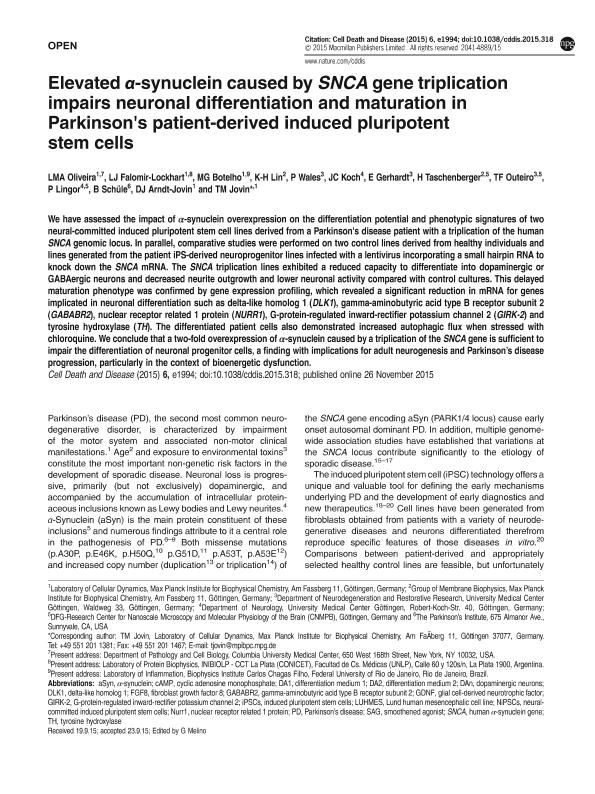Mostrar el registro sencillo del ítem
dc.contributor.author
Oliveira, L. M. A.
dc.contributor.author
Falomir Lockhart, Lisandro Jorge

dc.contributor.author
Botelho, M. G.
dc.contributor.author
Lin, K. H.
dc.contributor.author
Wales, P.
dc.contributor.author
Koch, J. C.
dc.contributor.author
Gerhardt, Elizabeth

dc.contributor.author
Taschenberger, H.
dc.contributor.author
Outeiro, T. F.
dc.contributor.author
Lingor, P.
dc.contributor.author
Schüele, B.
dc.contributor.author
Arndt Jovin, D. J.
dc.contributor.author
Jovin, T. M.
dc.date.available
2018-06-18T18:41:36Z
dc.date.issued
2015-11
dc.identifier.citation
Oliveira, L. M. A.; Falomir Lockhart, Lisandro Jorge; Botelho, M. G.; Lin, K. H.; Wales, P.; et al.; Elevated alpha-synuclein caused by SNCA gene triplication impairs neuronal differentiation and maturation in Parkinson's patient-derived induced pluripotent stem cells; Nature Publishing Group; Cell Death and Disease; 6; 11-2015; 1-13; e1994
dc.identifier.uri
http://hdl.handle.net/11336/49067
dc.description.abstract
We have assessed the impact of α-synuclein overexpression on the differentiation potential and phenotypic signatures of two neural-committed induced pluripotent stem cell lines derived from a Parkinson´s disease patient with a triplication of the human SNCA genomic locus. In parallel, comparative studies were performed on two control lines derived from healthy individuals and lines generated from the patient iPS-derived neuroprogenitor lines infected with a lentivirus incorporating a small hairpin RNA to knock down the SNCA mRNA. The SNCA triplication lines exhibited a reduced capacity to differentiate into dopaminergic or GABAergic neurons and decreased neurite outgrowth and lower neuronal activity compared with control cultures. This delayed maturation phenotype was confirmed by gene expression profiling, which revealed a significant reduction in mRNA for genes implicated in neuronal differentiation such as delta-like homolog 1 (DLK1), gamma-aminobutyric acid type B receptor subunit 2 (GABABR2), nuclear receptor related 1 protein (NURR1), G-protein-regulated inward-rectifier potassium channel 2 (GIRK-2) and tyrosine hydroxylase (TH). The differentiated patient cells also demonstrated increased autophagic flux when stressed with chloroquine. We conclude that a two-fold overexpression of α-synuclein caused by a triplication of the SNCA gene is sufficient to impair the differentiation of neuronal progenitor cells, a finding with implications for adult neurogenesis and Parkinson´s disease progression, particularly in the context of bioenergetic dysfunction.
dc.format
application/pdf
dc.language.iso
eng
dc.publisher
Nature Publishing Group

dc.rights
info:eu-repo/semantics/openAccess
dc.rights.uri
https://creativecommons.org/licenses/by/2.5/ar/
dc.subject
Parkinson´S Disease
dc.subject
Alpha-Synuclein
dc.subject
Gene Triplication
dc.subject
Induced-Pluripotent Stem-Like Cells
dc.subject.classification
Otras Ciencias Biológicas

dc.subject.classification
Ciencias Biológicas

dc.subject.classification
CIENCIAS NATURALES Y EXACTAS

dc.title
Elevated alpha-synuclein caused by SNCA gene triplication impairs neuronal differentiation and maturation in Parkinson's patient-derived induced pluripotent stem cells
dc.type
info:eu-repo/semantics/article
dc.type
info:ar-repo/semantics/artículo
dc.type
info:eu-repo/semantics/publishedVersion
dc.date.updated
2018-06-14T19:03:58Z
dc.identifier.eissn
2041-4889
dc.journal.volume
6
dc.journal.pagination
1-13; e1994
dc.journal.pais
Reino Unido

dc.journal.ciudad
Londres
dc.description.fil
Fil: Oliveira, L. M. A.. Max-Planck-Institut für biophysikalische Chemie; Alemania
dc.description.fil
Fil: Falomir Lockhart, Lisandro Jorge. Consejo Nacional de Investigaciones Científicas y Técnicas. Centro Científico Tecnológico Conicet - La Plata. Instituto de Investigaciones Bioquímicas de La Plata "Prof. Dr. Rodolfo R. Brenner". Universidad Nacional de la Plata. Facultad de Ciencias Médicas. Instituto de Investigaciones Bioquímicas de La Plata ; Argentina. Max-Planck-Institut für biophysikalische Chemie; Alemania
dc.description.fil
Fil: Botelho, M. G.. Max-Planck-Institut für biophysikalische Chemie; Alemania. Universidade Federal do Rio de Janeiro; Brasil
dc.description.fil
Fil: Lin, K. H.. Max-Planck-Institut für biophysikalische Chemie; Alemania
dc.description.fil
Fil: Wales, P.. Universität Göttingen; Alemania
dc.description.fil
Fil: Koch, J. C.. Universität Göttingen; Alemania
dc.description.fil
Fil: Gerhardt, Elizabeth. Universität Göttingen; Alemania
dc.description.fil
Fil: Taschenberger, H.. Max-Planck-Institut für biophysikalische Chemie; Alemania
dc.description.fil
Fil: Outeiro, T. F.. Universität Göttingen; Alemania
dc.description.fil
Fil: Lingor, P.. Universität Göttingen; Alemania
dc.description.fil
Fil: Schüele, B.. The Parkinson’s Institute; Estados Unidos
dc.description.fil
Fil: Arndt Jovin, D. J.. Max-Planck-Institut für biophysikalische Chemie; Alemania
dc.description.fil
Fil: Jovin, T. M.. Max-Planck-Institut für biophysikalische Chemie; Alemania
dc.journal.title
Cell Death and Disease
dc.relation.alternativeid
info:eu-repo/semantics/altIdentifier/url/https://www.nature.com/articles/cddis2015318
dc.relation.alternativeid
info:eu-repo/semantics/altIdentifier/doi/https://doi.org/10.1038/cddis.2015.318
Archivos asociados
